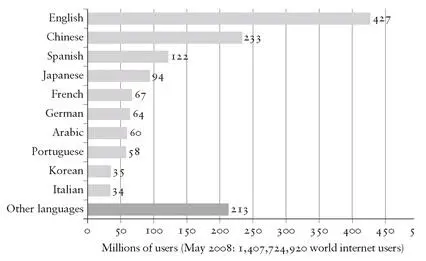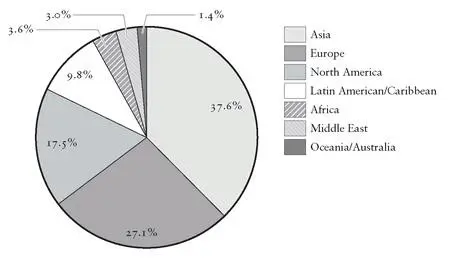Another example will be provided by tourism. The United Nations World Tourism Organization predicts, rather conservatively, that there will be 100 million outward-bound Chinese tourists by 2019 (compared with almost 28 million in 2004), and an estimated global total of 1.6 billion in 2020. The World Travel and Tourism Council has predicted that by 2018 the value of Chinese tourism will almost be as great as that of the United States. The impact will be greatest in East Asia, especially South-East Asia, and Australia, where many destinations will seem as if they have been taken over by Chinese tourists, a phenomenon that hitherto has been almost exclusively Western, but which will happen on a far grander scale with the Chinese. [1254] [1254] Wolfgang Georg Arlt, China’s Outbound Tourism (London: Routledge, 2006), pp. 67, 227-8.
The Chinese language, similarly, will assume global importance simply because it has so many native speakers; this will contrast with recent periods of history when the USSR and later Japan were riding high but which, partly because of their relatively small populations, had little linguistic impact, apart from on Eastern Europe in the case of the Soviet Union, outside their own borders. In terms of language, it is already possible to glimpse the future through those who use the internet. Though the proportion of China ’s population who are internet users is far smaller than that in the United States, by 2008 the number of Chinese internet users had already overtaken the number of American users. [1255] [1255] ‘China Soon to be World’s Biggest Internet User’, Guardian , 25 January 2007; ‘US Slips on the Web’, International Herald Tribune , 11 May 2006.

Figure 44. Top ten internet languages, May 2008.

Figure 45. World internet users, March 2008.
For the last two centuries Caucasians have enjoyed a privileged position at the top of the global racial hierarchy. During the period of European colonial empires their pre-eminent position was frequently explained in terms of racial theories designed to show the inherent superiority of the white race. Since the mid twentieth century, with the defeat of Nazism followed by colonial liberation, such explicitly racial theories have been in retreat in most regions of the world and now enjoy only minority appeal in the West. Nonetheless, if such racial theories are no longer regarded for the most part as acceptable, there remains an implicit and omnipresent global racial pecking order, with whites invariably at the top. Various factors helped to shape this hierarchy, including levels of development, skin colour, physical characteristics, history, religion, dress, customs and centuries-old racist beliefs and prejudices. Throughout the world, white people command respect and deference, often tinged with fear and resentment, an attitude which derives from a combination of having been globally dominant for so long, huge wealth and power, and genuine achievement. The rise of China to surpass the West will, over time, inevitably result in a gradual reordering of the global hierarchy of race. [1256] [1256] Martin Jacques, ‘Global Hierarchy of Race’, Guardian , 20 September 2003.
Although possessed of an inner belief that they are superior to all others, the Chinese sense of confidence was shaken and in part undermined by the ‘century of humiliation’. This found expression during the 1980s in what Wang Xiaodong has described as ‘reverse racism’, or a desire to ape and copy the West, and denigrate things Chinese. [1257] [1257] Wang Xiaodong, ‘Chinese Nationalism Under the Shadow of Globalisation’, lecture, London School of Economics, 7 February 2005, pp. 1–2.
That phase, however, is increasingly giving way to a growing sense of self-belief and a return to older attitudes. The idea that China must learn from the West is being joined by the proposition that the West needs to learn from the East. [1258] [1258] Zhao, A Nation-State by Construction , pp. 147-9.
The fact that the Chinese sense of superiority survived more than a century of being hugely outperformed by the West is testament to its deeply ingrained nature. As China becomes a major global player, this feeling of superiority will be supported and reinforced by new rationales, arguments and evidence. Chinese racial discourse, furthermore, as we saw in Chapter 8, differs in important respects from that of Europe, primarily because its origins lie in China ’s existence as a civilization-state rather than as a nation-state.
In a few limited areas, such as football, athletics and popular music, the global predominance of Caucasians has come under significant challenge. But the ubiquity of the white role-model in so many spheres — business, law, accounting, academe, fashion, global political leadership — still overwhelmingly prevails. Figures like Barack Obama and Tiger Woods remain very much the exception, though the former’s election as American president is highly significant in this context. Nelson Mandela came to enjoy enormous moral authority throughout the world but enjoyed little substantive power. With the rise of China, white domination will come under serious challenge for the first time in many, if not most, areas of global activity.
The pervasive importance of racial attitudes should not be underestimated. International relations scholars have persistently neglected or ignored their significance as a major determinant of national behaviour and global relations, preferring instead to concentrate on nationalism; yet, as we saw in Chapter 8, race and ethnicity are central to the way in which nations are constructed. [1259] [1259] Alastair Iain Johnston and Robert S. Ross, New Directions in the Study of China’s Foreign Policy (Stanford: Stanford University Press, 2006), pp. 410-11.
This has been well described by the Chinese international relations scholar Zi Zhongyun in the case of the United States. [1260] [1260] Zi Zhongyun, ‘The Clash of Ideas: Ideology and Sino-US Relations’, in Suisheng Zhao, ed., Chinese Foreign Policy: Pragmatism and Strategic Behaviour (New York: M. E. Sharpe, 2004), pp. 224-42.
The fact that there has been virtually no challenge to, or questioning of, widely held racial prejudices in China, that they are regarded as normative rather than abnormal and that there is no culture of anti-racism, means that they will continue to exercise a powerful influence on how China sees the world, how the Chinese at all levels of society regard others, and how China will behave as a nation. Of course, as China becomes increasingly open to the world and mixes with it on a quite new basis following centuries of being relatively closed, then some of the old prejudices are bound to wither and disappear, but the persistence of these kinds of attitudes, rooted as they are in such a long history, will remain. As the dominant global power, China is likely to have a strongly hierarchical view of the world, based on a combination of racial and cultural attitudes, and this will play a fundamental role in shaping how China views other nations and peoples and its own position at the top of the ladder.
The concept of the West is intimately linked to European expansion and the migration of its population to far-flung parts of the world. This is a neglected issue, something that is largely taken for granted and little scrutinized. It was European emigration that led to the creation of the United States as a white-dominated society in the northern part of the American continent, and likewise in the case of Canada. The term ‘Latin America’ derives from the Spanish and Portuguese colonization of South America and to this day finds expression in the fact that the elite in these countries remains predominantly white and is largely descended from the original colonial families. [1261] [1261] Richard Gott, ‘Latin America is Preparing to Settle Accounts with Its White Settler Elite’, Guardian , 15 November 2006; Amy Chua, World on Fire: How Exporting Free Market Democracy Breeds Ethnic Hatred and Global Instability (London: William Heinemann, 2003), Chapter 2.
Similarly, British migration created a white Australia — which, together with New Zealand, formed in effect an Asia- Pacific outpost of the West — based on the suppression, decimation and subsequent marginalization of the indigenous Aborigine peoples. But for that, Australia and New Zealand would today be Aboriginal and Maori countries respectively, with entirely different names, languages and cultures. If European migration to South Africa had been on a much greater scale, then the large white minority population might have been in a majority, thereby making white rule permanent. The European, or white, diaspora has had a huge impact on the nature and shape of the world as we know it.
Читать дальше














